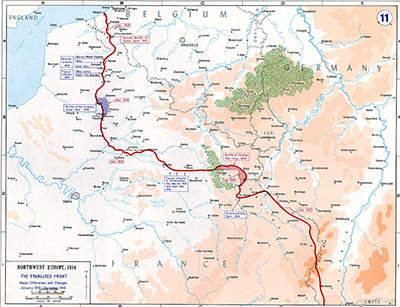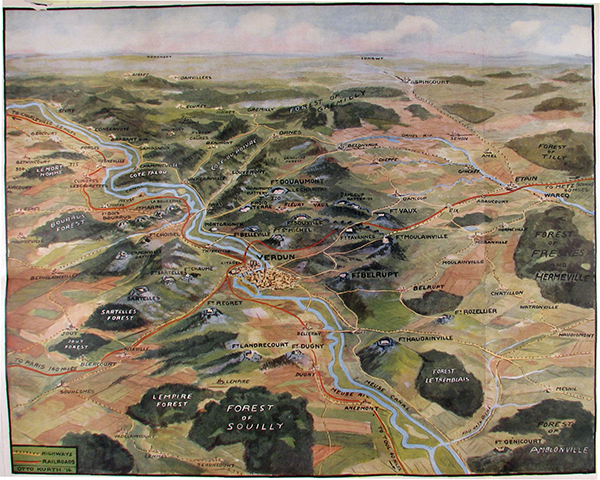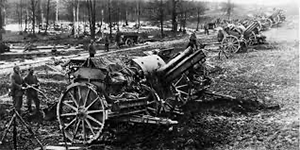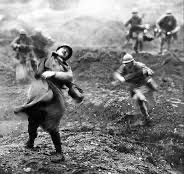The Battle of Verdun
The Battle of Verdun was the longest battle of the First World War. A titanic struggle, it was a microcosm of the war as a whole: hundreds of thousands of dead, injured, and captured in order to take or defend significant landmarks and small amounts of territory. 
After a series of victories in 1914 and a consequent serious push into northeastern France, German forces found themselves stymied at the First Battle of the Marne and stepped back, digging trenches in order to maintain the front rather than moving it forward. British and French forces counterattacked, claiming some small victories, but 1915 was largely a year of stalemate. The German high command, then led by Chief of Staff Erich von Falkenhayn, decided on a strategy of war by attrition and, to that end, targeted Verdun as the next stronghold for German troops to seize. It was a well protected city, its own defenses strong but its approach also looked after by an extensive network of forts and fortifications. French forces had moved some big guns and many troops out of Verdun in order to deal with German attacks elsewhere, but the city and its environs were still very well defended. 
German forces ringed Verdun on three sides. The one place from which French reinforcements could still come was on the Voie Sacrêe (Sacred Road), a well defended lifeline to the French interior. French forces were scattered somewhat at the end of the first year of the war. All of these factors convinced Falkenhayn and his commanders that taking control of Verdun was not only possible but also desirable. As the winter of early 1916 progressed, German forces concentrated in the area. 
The attack was planned for February 12. Inclement weather forced a postponement, allowing French reinforcements to arrive. Still, not long after dawn on February 21, the German artillery barrage began. It continued for 10 hours. Among the first German troops to assault the French troops were soldiers wielding flamethrowers. Following them were wave after wave of well trained fighters. The defenders retreated in the face of the onslaught, giving way for a full three miles. The pattern continued, with Germany advancing farther and farther onward, getting closer and closer to Verdun. 
Fourt Douamuont was one of the city's strongest citadels. It fell on February 25. French reinforcements saved the village of the same name. By this time, the German footsoldiers had outrun their big guns. They paused for a time, consolidating forces. Then, they began to hit Verdun itself. The German attackers were successful in taking the hills of Cote 304 and Le Mort Homme, giving the invaders control of the eastern part of the city. While this was happening, other big guns were shelling other forts around the area, including Fort Vaux. The battle for that particular landmark went on for several weeks before German forces took the fort. As well, German forces captured a handful of French cities and destroyed a few others. Ahead of the assault on their next target, Fort Souville, the Germans launched poison gas shells. The attack on that fort began on June 23, and German soldiers crested the summit on July 12. They could not hold it, however, and gave way in the face of determined defense. By this time, with German forces in control of much of the surrounding landscape, including a number of forts and fortifications, the Allied armies had begun an attack further north, on the River Somme. Responding to that massive wave, the German high command shifted some of its forces from Verdun to the Somme, while at the same time refocusing on the war in the east, in response to a major Russian victory over Austria-Hungary in what is now Ukraine. Meanwhile, French forces continued to resist, hitting the German invaders every so often with a combination of big guns and attacks on foot. French troops retook the forts of Douaumont and Vaux in late October and early November. As the calendar year was ending, the French wave of counterattacks had pushed the German aggressors back almost to where they had started. The official end date of the battle is Dec. 18, 1916. The start date was February 21 of that same year. In those months, hundreds of thousands of soldiers died. Estimates widely vary, but most sources quote figures on both sides that are roughly equal with each other. The German strategy of winning a war of attrition had certainly removed a great part of the French defense force; however, a great part of the German force was gone as well. |
|
Social Studies for Kids
copyright 2002–2026
David White




